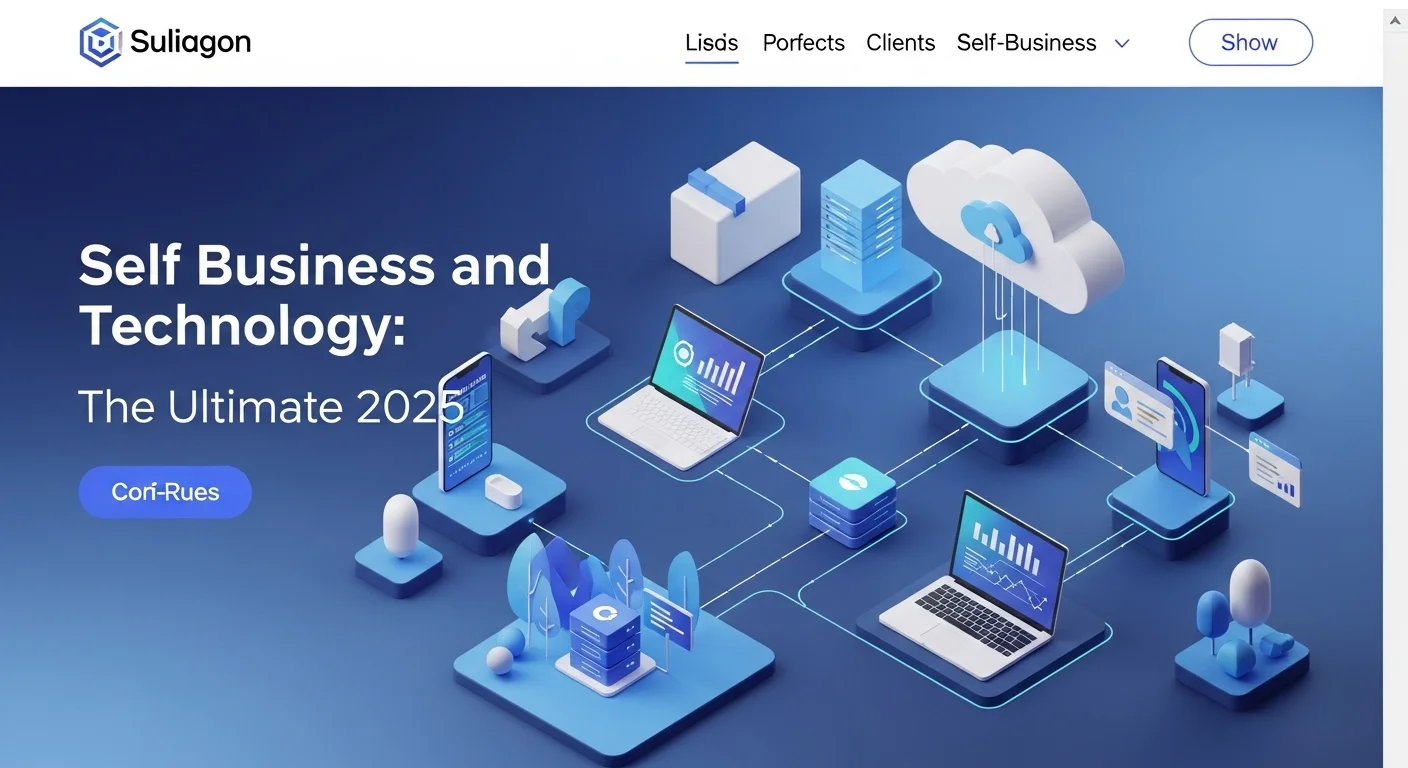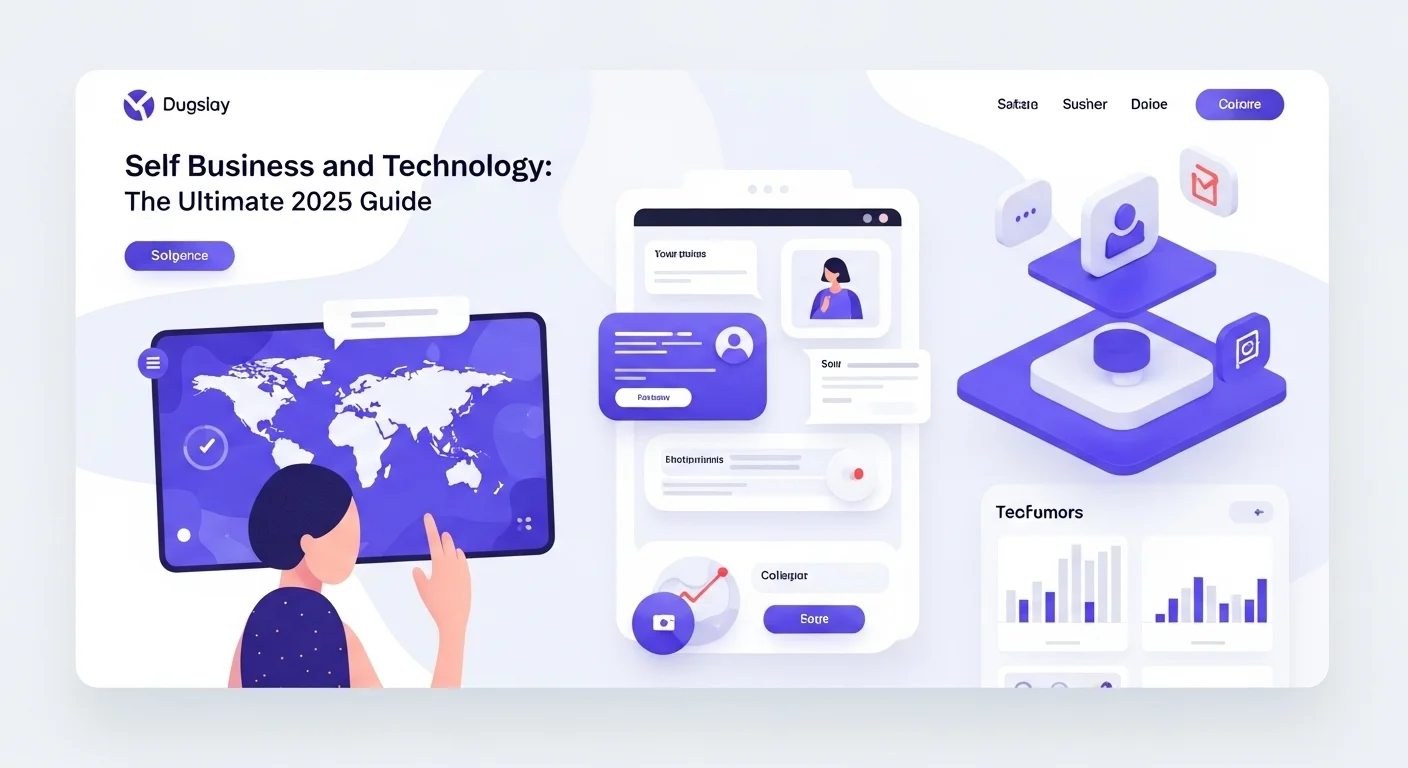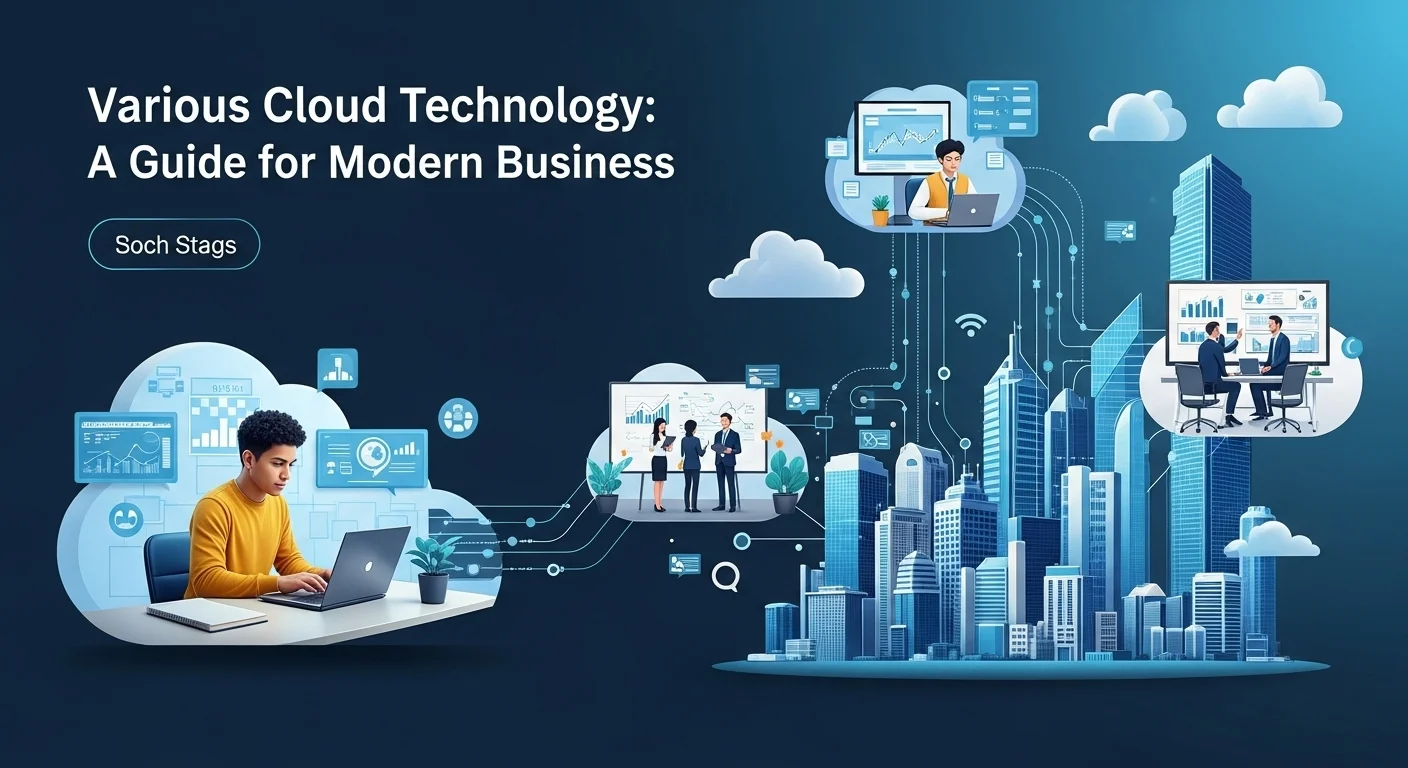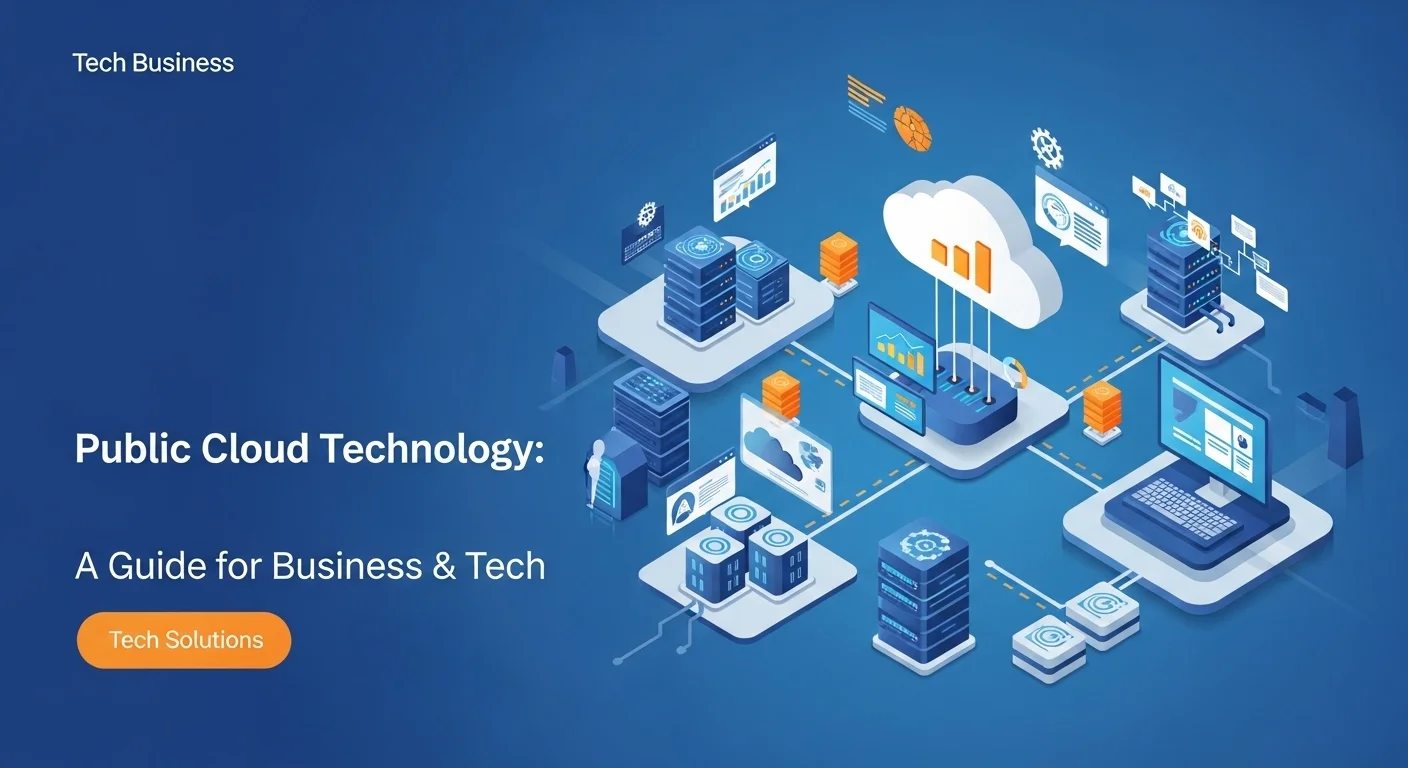Your One-Person Tech Empire: A Real-World Guide to Self-Business

Executive Summary
The dream of being your own boss has changed. It's no longer about just freelancing; it's about building a real, scalable business, all by yourself. I call this a 'Self-Business,' and it's a path I've walked for years. The secret? Technology. It's the great equalizer, giving us solopreneurs the power that once belonged only to large companies. From AI that acts as your marketing assistant to cloud services that provide a global backbone, the tools are finally here. In this guide, I'm going to cut through the noise and share what actually works. We'll explore powerful business ideas, from creating niche software to tech consulting, and I'll give you a practical roadmap to build a resilient and profitable one-person company in today's digital world.
Table of Contents
Table of Contents
What is a Self-Business, Really?
Let's talk about what a 'Self-Business' actually is. For me, it's the evolution of freelancing. It’s not just about trading your hours for dollars; it's about creating a business system that you, a single individual, own and operate. Think of it as building a small, smart empire where you're the architect. The goal isn't just to work for yourself, but to build something with real value—an asset that can generate revenue even when you're not at the keyboard. The reason this is a huge deal right now, especially in tech, is simple: technology gives you leverage. A few years ago, the idea of one person launching a global software product or a consulting firm with international clients was almost unthinkable. It would have required a massive team and huge investment. Now, thanks to cloud computing, AI, and incredible SaaS platforms, that dream is within reach for anyone with a good idea and the drive to see it through. Technology is the engine that makes these solo ventures not just possible, but incredibly profitable.
The Partnership Between Technology and the Solopreneur
I've always seen the relationship between a solopreneur and technology as a partnership. One can't truly thrive without the other. On one hand, technology has torn down the old barriers to starting a business. I remember when launching a simple website required a developer and a server in a closet. Today, you can use a platform like Shopify to launch a global storefront in an afternoon, manage complex projects with Trello, or run a sophisticated ad campaign with AI tools. The cost of entry has plummeted. Instead of needing a huge loan for servers and office space, you can 'rent' world-class infrastructure from Amazon Web Services (AWS) or Google Cloud and pay only for what you use. This changes the game completely, turning massive upfront costs into manageable monthly expenses.
On the other hand, we, the millions of solopreneurs, have created a huge market that tech companies are scrambling to serve. An entire ecosystem of tools has sprung up just for us. Think of AI writing assistants like Jasper or all-in-one business platforms like Flowlu—they're designed to make a single person as productive as a small team. It's a fantastic cycle: better technology empowers more people to start a self-business, which creates demand for even better tools. This dynamic is constantly sparking new business ideas and making it one of the most exciting times to be an entrepreneur.
Where Tech-Focused Self-Businesses Are Winning
The beauty of this model is how flexible it is. You can build a business around your specific skills. I've seen people succeed in so many different areas. Here are some of the fields where I see tech-focused solopreneurs crushing it right now:
- Niche SaaS (Software-as-a-Service): This is a personal favorite. Instead of trying to build the next big thing, a solopreneur can create a small tool that solves one specific problem for one specific audience. I know a developer who built a simple browser extension for Shopify merchants that saves them hours each week. He now has a recurring revenue business. With no-code tools like Bubble, you don't even need to be a programmer to build a functional app.
- Specialized Tech Consulting: If you have deep expertise in something like cybersecurity or cloud architecture, you can build a very profitable consulting business. I've helped small businesses set up their cybersecurity policies because they can't afford a full-time expert. You're selling your knowledge, and that's an asset that scales beautifully.
- Modern E-commerce: Selling online is easier than ever. You can curate products and sell them globally with platforms handling the tech side. The dropshipping model is still viable, as it removes the headache of managing inventory. With today's analytics and AI marketing tools, a single person can run an online store with the sophistication of a much larger retailer.
- Digital Products and Content Creation: This is the classic self-business model for a reason. You can package your expertise into online courses, templates, or a paid newsletter. I started by creating a small course on project management for developers. The best part? Once you create it, you can sell it over and over with almost zero additional cost. The entire creator economy is built on this powerful idea.
- Managed Service Provider (MSP): If you're tech-savvy, you can offer IT services to small businesses that need help. This could be managing their cloud backups, providing tech support, or handling their software updates. This creates a predictable, recurring revenue stream, which is the gold standard for any solo business.
The Real-World Benefits of Going Solo in Tech
Why do so many of us choose this path? It comes down to a few core benefits that are especially powerful in the tech world.
1. True Flexibility and Autonomy: This is the big one. You control your schedule, your location, and the work you choose to do. It’s about designing a life, not just a job. The freedom to work from a coffee shop, travel, or just be home for your family is something you can't put a price on.
2. Low Costs and High Profit Margins: Without payroll or rent, your overhead is incredibly low. I run my entire business on a handful of subscriptions. This lean structure means your profit margins can be amazing. While a traditional agency might aim for 20%, a successful self-business selling services or digital products can easily hit 80% or more.
3. Direct Connection to Your Customers: There's no one between you and the people you serve. This direct feedback is invaluable. You learn what your customers really need, you can adapt quickly, and you build strong relationships that lead to loyalty and referrals. This agility is your superpower against big, slow companies.
4. You Own 100% of Your Work: Every bit of effort you put in builds your own asset, not someone else's. The brand, the code, the content—it's all yours. A successful self-business can provide you with income for years, and it's a valuable asset you can even sell down the line.
5. You Never Stop Learning: When you run the whole show, you have to wear many hats. You become the marketer, the salesperson, the strategist. It can be challenging, but it forces you to grow in ways you never would in a traditional job. Honestly, the journey of building something from scratch is one of the most rewarding things you'll ever do.

A Complete Guide to Technology and Business Solutions for Your Self-Business
Starting a tech-focused Self-Business isn't just about having a great idea. It’s about knowing which tools to use and how to combine them with smart business strategies. I've spent years figuring this out through trial and error. This guide is the roadmap I wish I had when I started, designed to give you the practical knowledge to turn your business idea into a successful reality. The modern solopreneur is a master of leverage, and I'll show you exactly how to use technology to amplify your efforts.
Core Technological Methods for the Modern Solopreneur
Your technology stack is the foundation of your business. Choosing the right tools is a strategic decision that will affect how you grow, how much you spend, and how efficiently you can work. Here's my breakdown of the essentials.
1. Mastering the Cloud: Your Virtual Headquarters
Think of the cloud as your digital office and warehouse, all rolled into one, but without the rent. It gives you access to powerful infrastructure without needing to buy any physical hardware. This is a game-changer for any solo venture.
- Infrastructure as a Service (IaaS): This is like renting a virtual computer. Services like Amazon EC2 let you host your own apps or websites. You pay for what you use, so you can start small and grow as your business does.
- Platform as a Service (PaaS): Platforms like Heroku handle all the server management for you. You just focus on your code. This is my go-to recommendation for developers who want to launch products fast without getting bogged down in server administration.
- Software as a Service (SaaS): As a business owner, you'll live on SaaS tools. From QuickBooks for accounting to HubSpot for managing customer relationships, these are the apps that run your business day-to-day.
- Serverless Computing: This is the peak of efficiency. It lets you run code in response to specific events, like a user uploading a photo, without any servers to manage at all. It's incredibly cost-effective for tasks that don't need to run constantly.
2. Artificial Intelligence and Automation: Your Digital Team
AI isn't science fiction anymore; it's a practical tool that I use every single day. It can be your co-writer, your marketing assistant, and your admin. Getting good at automation is what allows a one-person business to scale.
- Content and Marketing: Tools like ChatGPT are amazing for brainstorming and drafting blog posts, social media updates, and emails. It frees me from staring at a blank page and lets me focus on adding my own expertise.
- Customer Support: Simple AI chatbots can be added to your website to answer common questions 24/7. This gives your customers instant help and frees you up to handle the more complex problems.
- Workflow Automation: This is my secret weapon. Tools like Zapier or Make are the glue that connects all your different apps. For example, I have an automation set up: 'When someone pays me via Stripe, they are automatically added to my email list in Mailchimp and a new project folder is created in Notion.' Setting these up is like hiring a robot to do your admin work.
- Data Insights: Even as a small business, you can use AI to analyze your sales data and spot trends. This helps you make smarter decisions about what to build or sell next.
3. Cybersecurity: Protecting Your Livelihood
When you're a one-person business, you are the entire IT department. A security breach could ruin you, so you have to take it seriously. It's not as complicated as it sounds.
- Use a VPN: A Virtual Private Network encrypts your internet connection. I never work from a coffee shop or airport without turning my VPN on.
- Practice Good Password Hygiene: Don't use the same password everywhere. A password manager like 1Password is a must-have. It creates and saves strong, unique passwords for you.
- Enable Multi-Factor Authentication (MFA): Turn this on for every important account. It adds a second layer of security, usually a code from your phone, and it's one of the most effective ways to stop hackers.
- Back Up Everything: Your data is your business. Follow the 3-2-1 rule: three copies of your data, on two different types of media, with at least one copy stored off-site (in the cloud).
- Encrypt Your Devices: Encrypt your laptop's hard drive. It's built into most modern operating systems. This means if your laptop is stolen, your data is unreadable.
4. No-Code/Low-Code: Building Without Being a Coder
The rise of no-code platforms has opened up entrepreneurship to so many more people. These tools let you build professional websites and applications with a visual, drag-and-drop interface.
- Webflow: Perfect for building stunning, professional websites that look completely custom.
- Bubble: You can build surprisingly complex web applications with Bubble, including databases and user accounts. I've seen entire SaaS businesses built on it.
- Glide: This tool lets you turn a simple Google Sheet into a functional mobile app for both iOS and Android.
These tools are incredible for testing a business idea quickly. You can build a Minimum Viable Product (MVP) in days, not months, to see if people are actually interested before you invest a ton of time or money.
Essential Business Techniques for Sustainable Growth
The best tech in the world won't save a bad business model. You need to combine your tools with solid business practices to build something that lasts.
1. The Lean Startup Approach: Don't spend a year building your 'perfect' product in secret. Build a simple version first (your MVP), show it to real people, and listen to their feedback. This Build-Measure-Learn cycle ensures you don't waste time building something nobody wants.
2. Find Your Niche: You can't be everything to everyone. Your power as a solopreneur is in specialization. Don't just be a 'web designer.' Be a 'web designer for independent coffee shops.' This makes your marketing a hundred times easier and allows you to charge more for your expertise.
3. Content Marketing is Your Friend: The best way to get clients is to have them come to you. You do this by creating helpful content—blog posts, videos, tutorials—that solves their problems. When you optimize this for search engines (SEO), people will find you when they're actively looking for help. It's the most powerful marketing engine for a solo business.
4. Get Serious About Your Finances: Keep your business and personal bank accounts separate from day one. Use simple accounting software like Wave (it's free!) or QuickBooks Self-Employed to track your income and expenses. Understand your numbers and always set aside money for taxes.
5. Guard Your Time Fiercely: Your time is your most valuable resource. Use techniques like time blocking to dedicate specific hours to specific tasks. Be ruthless about automating or eliminating tasks that don't directly contribute to your bottom line. I use a project management tool like Notion to plan my weeks and keep me focused on what matters.

Tips and Strategies to Master Your Tech-Powered Self-Business
Getting your business off the ground is one thing; turning it into a thriving, resilient enterprise is another. It's about the daily habits and advanced strategies you adopt. It's about refining your process until your business runs like a well-oiled machine. In this section, I want to share some of the more advanced practices that took my own business to the next level. These are the tips that help you move from simply working for yourself to truly owning your success.
Advanced Best Practices for the Elite Solopreneur
These are the habits that separate the pros from the amateurs. They might seem small, but they make a huge difference in your ability to scale and stay sane.
1. Build a 'Second Brain': Organize Your Digital Life
As a solopreneur, everything is in your head—client details, project notes, new ideas. It's exhausting. I highly recommend building what's called a 'Second Brain' using a tool like Notion or Obsidian. It's a central place to capture, organize, and find any piece of information related to your business. By getting it all out of your head and into a trusted system, you free up mental space for creative thinking and big-picture strategy. It's the best thing I ever did for my productivity.
2. Systemize Everything: Pretend You're Hiring
Even if you never plan to hire anyone, build your business as if you were. This means creating simple step-by-step guides, or Standard Operating Procedures (SOPs), for every task you do repeatedly. How do you onboard a new client? How do you publish a blog post? Write it down. This forces you to make your processes more efficient and turns your business into a set of repeatable systems. If you ever do hire a virtual assistant, you can just hand them the playbook.
3. Embrace 'Async' Communication
Back-to-back meetings and constant chat notifications are the enemies of deep work. I run my business primarily on asynchronous communication. Instead of a 30-minute call for a simple update, I'll send a detailed email or record a quick video with Loom. This respects everyone's time and allows me to stay focused. I set clear expectations with clients from the start about how we'll communicate, protecting my focus and making me look more professional.
4. Build Real Relationships, Not Just a Network
Forget about collecting hundreds of business cards. Instead, focus on building a handful of genuine relationships with other people in your field. Join a small online community, offer help freely, and be a resource for others. My best clients and biggest breakthroughs have almost all come from referrals and conversations with a small, trusted group of peers.
5. Use Data to Inform, Not Dictate
Analytics are important, but don't let them paralyze you. Use data to understand what's happening, but trust your gut and your vision. Be ready to pivot. If your first idea isn't working, use the feedback you've gathered to try something new. The most successful entrepreneurs I know weren't the ones with the perfect initial idea; they were the ones who were best at listening and adapting.
Cutting-Edge Business Tools and Tech Experiences
To stay competitive, you need to use the best tools available. Here are a few that can give you a serious edge:
- Financial and Legal Tech: For company formation, a service like Stripe Atlas is amazing. It handles the complex legal stuff for you. For ongoing finances, services like Bench give you a dedicated bookkeeper, which is a massive relief come tax time.
- AI-Powered Productivity: I'm exploring tools that go beyond writing. Motion uses AI to automatically schedule your tasks into your calendar, creating the perfect work day for you. Another one, Fireflies.ai, can join your video calls, transcribe them, and create summaries. It's like having a personal assistant at every meeting.
- Advanced Marketing Automation: When you're ready to get more sophisticated with email, a tool like ActiveCampaign lets you create personalized marketing journeys for your customers based on their actions. It's powerful stuff.
Tech Experience Case Study: The One-Person Cybersecurity Consultancy
Let's imagine a self-business called 'SecureSolo,' run by an expert cybersecurity consultant. Here’s how she uses tech to run an efficient, high-value practice:
1. Getting Leads: She writes in-depth articles about cybersecurity for small tech companies. The content is optimized for Google using SEO tools. She uses AI to help brainstorm topics and create outlines, then adds her own deep expertise.
2. Onboarding Clients: When a lead fills out her website contact form, an automation kicks in. It creates a client profile in her CRM, sends them a link to book a call on her calendar, and adds a task for her to review their company before the meeting.
3. Delivering the Service: For security audits, she uses automated tools for the initial scan. Then, she personally analyzes the results and creates a custom strategic report. This blends automation for speed with her human expertise, which is what clients pay for.
4. Managing Projects: All client communication happens in a shared portal built in Notion. This keeps everything organized in one place and avoids messy email threads.
5. Getting Paid: Invoices are handled through Stripe. Her accounting is managed by Bench, so she gets clean financial reports every month without having to do it herself.
This shows how a single person can build a sophisticated and profitable consulting business by smartly integrating modern tools.
External Links for Continuous Learning
The tech world moves fast. You have to keep learning. Here are a few resources I personally recommend:
- Tech and Strategy News: For brilliant insights into the business of technology, I read Stratechery by Ben Thompson every week.
- Startup Advice: The blog and library from Y Combinator are a goldmine of information on building and growing a business.
- AI News: To keep up with Artificial Intelligence, I subscribe to newsletters like The Neuron. They make complex topics easy to understand.
By blending these best practices with cutting-edge tools and a commitment to learning, you can build a self-business that is not just a job, but a resilient and rewarding asset. The future belongs to the agile solopreneur, and there has never been a better time to build something of your own.
Expert Reviews & Testimonials
Sarah Johnson, Business Owner ⭐⭐⭐
The information here is solid, but as a business owner, I was hoping for a few more real-world examples I could directly apply.
Mike Chen, IT Consultant ⭐⭐⭐⭐
A helpful overview of the self-business world. It clarified a lot for me, though I felt some of the tech explanations could have been a bit simpler.
Emma Davis, Tech Expert ⭐⭐⭐⭐⭐
Absolutely fantastic article! As a tech specialist, this was incredibly comprehensive and helped me connect the dots for my own work. Everything was explained perfectly.



